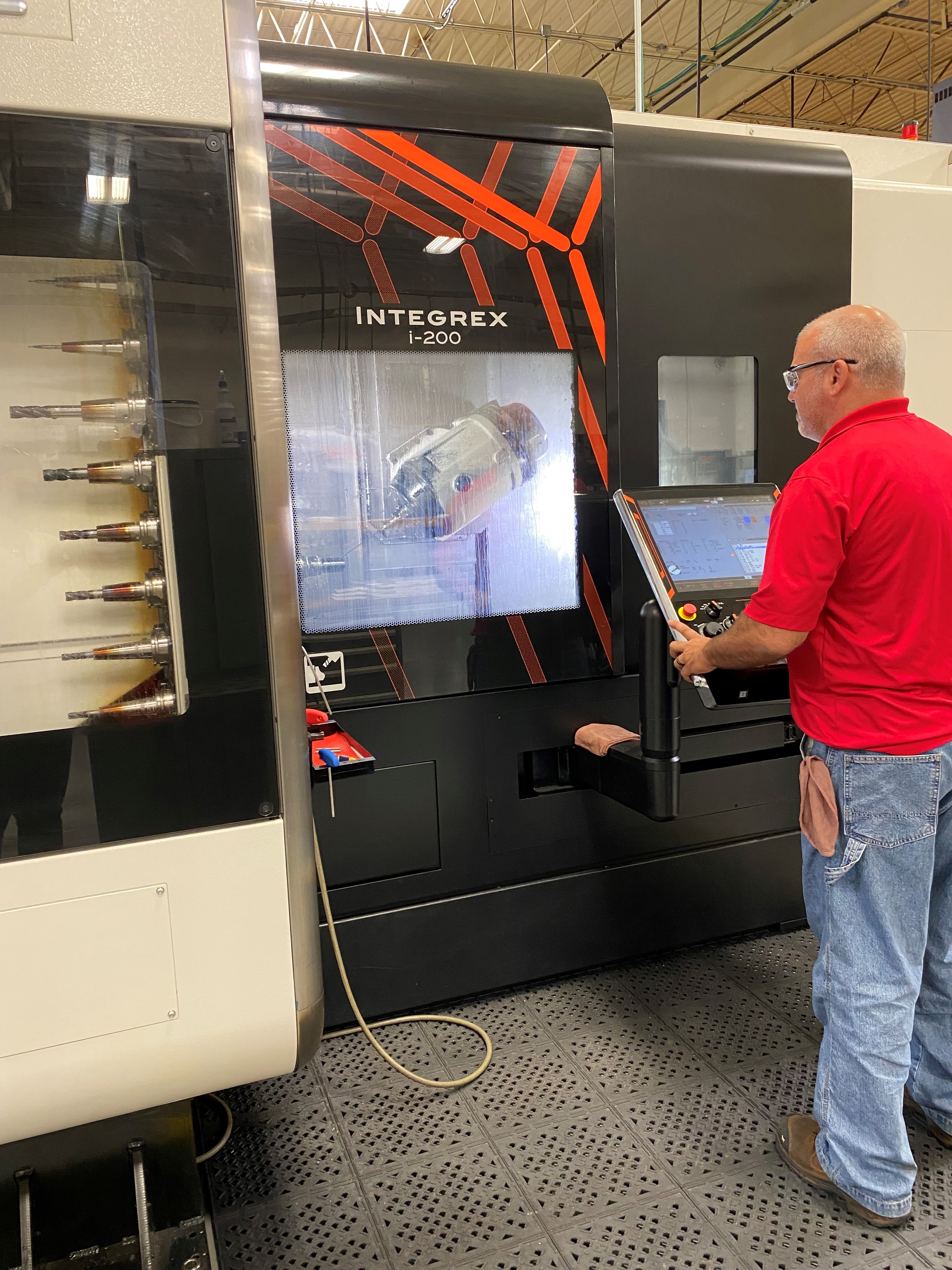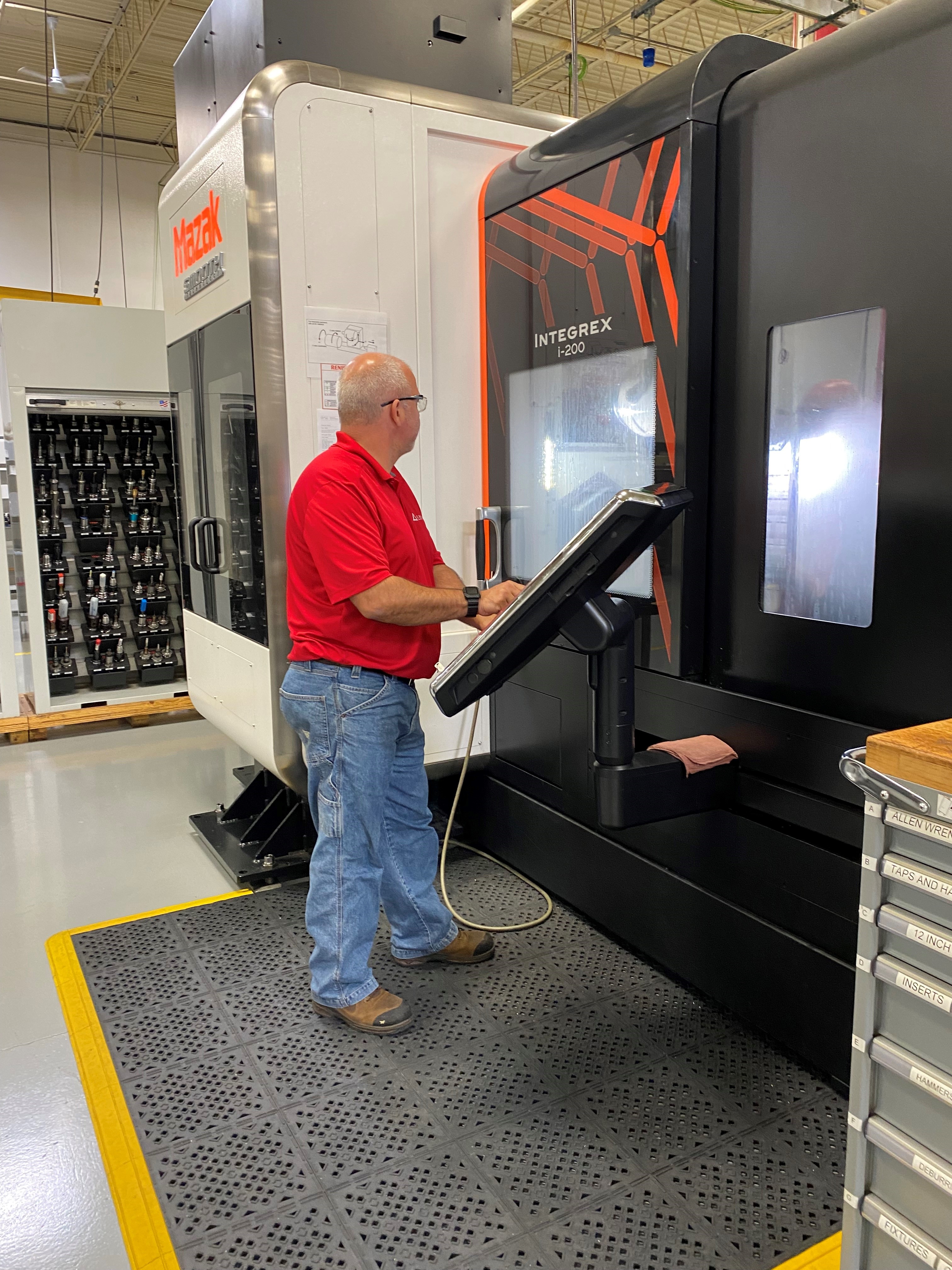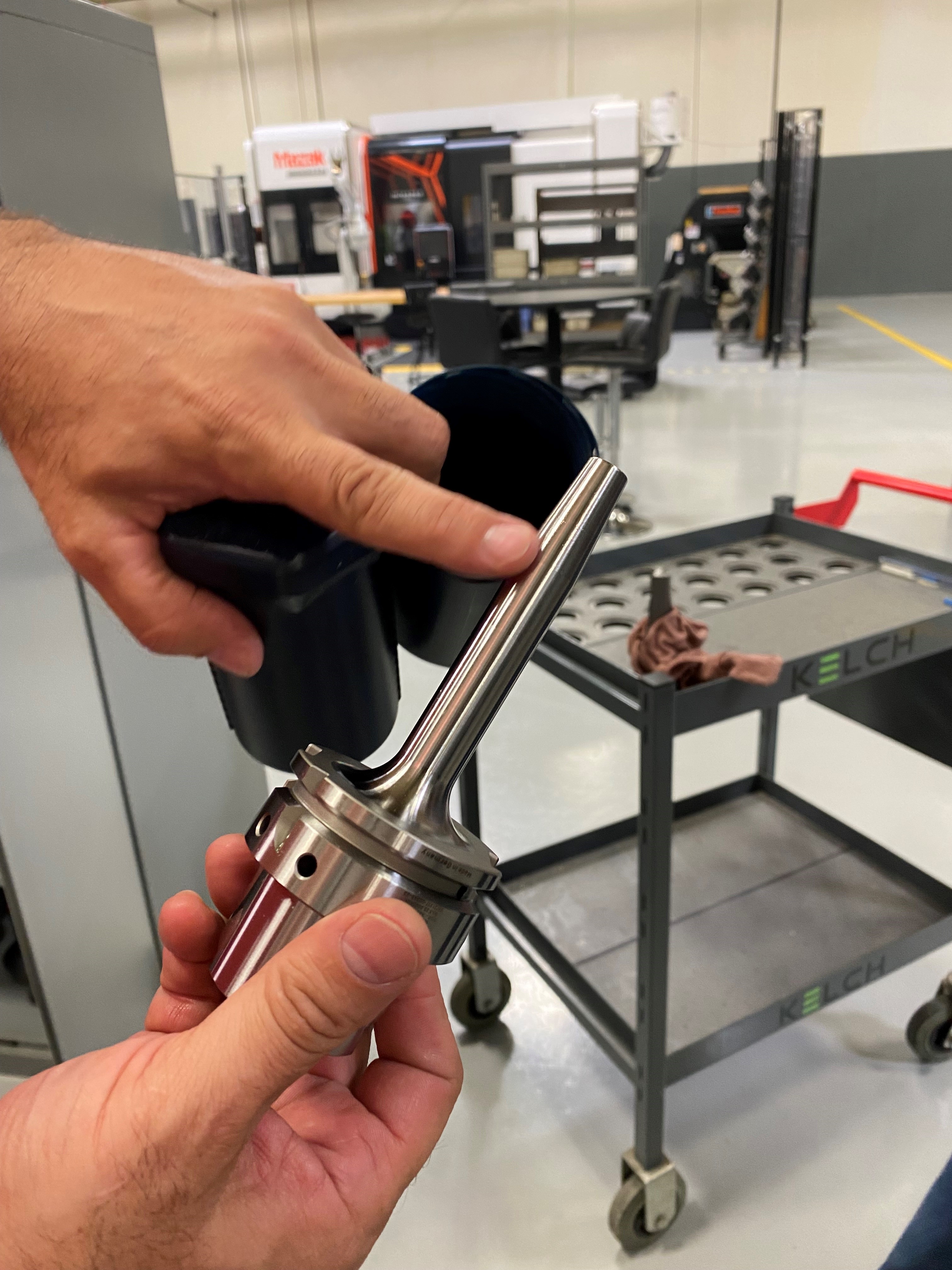 Veteran machinists might remember their first use of an indexable insert drill. Suddenly, the taper shank and Silver and Deming drills they’d been struggling with for years were obsolete, replaced by cutting tools able to drill holes at least four times faster than their high-speed steel, non-coolant fed counterparts. No more pecking, no more spotting drills or pilot holes, no more drill wander or stopping production to sharpen a worn drill bit—simply load up a fresh set of inserts and get drilling.
Veteran machinists might remember their first use of an indexable insert drill. Suddenly, the taper shank and Silver and Deming drills they’d been struggling with for years were obsolete, replaced by cutting tools able to drill holes at least four times faster than their high-speed steel, non-coolant fed counterparts. No more pecking, no more spotting drills or pilot holes, no more drill wander or stopping production to sharpen a worn drill bit—simply load up a fresh set of inserts and get drilling.
The chances are good that the logo inscribed on that revolutionary cutting tool spelled KUB. First introduced in 1977, Ceratizit’s Komet KUB product category of insert drills paved the way to easier, more productive and accurate holemaking. The century-old German cutting tool manufacturer—now part of the Ceratizit Group—took holemaking even further with the KUB Trigon in 1995, a design that continues to set today's indexable drilling standard.
Drilling drills
Rick Cahn knows as much about the KUB Trigon drill as anyone. He applied for an entry-level assembly and deburring job at Ceratizit USA’s (formerly Komet of America) Schaumburg, Illinois, facility in 1994—just a few months before the product’s debut—and has been there ever since.
"After my first year, they let me apply for the apprenticeship program, and four years after that, I graduated to the CNC machining department,” says Cahn. “Since then, I’ve worked on everything from our standard product lines like drills and cartridges to all manner of special tooling—chamfer tools, boring bars, form cutters ... you name it.”
Cahn’s also made his fair s hare of KUB drills. As you’ll see, the manufacturing approach has changed a great deal recently, but it was once a "fairly lengthy process" that required multiple machining operations.
hare of KUB drills. As you’ll see, the manufacturing approach has changed a great deal recently, but it was once a "fairly lengthy process" that required multiple machining operations.
"Back then, we used a pair of CNC lathes and a rotary table-equipped machining center to rough turn both ends, drill the coolant holes, and mill a pair of straight flutes, after which the partially completed drill would go into an induction heating device,” he said. “There, it was brought up to 1000 degree F or so in less than ten seconds and then twisted to generate the spiral flutes."
When cool, the drill was sent back to the CNC department for finish turning, milling of the insert pockets, and then heat-treated to the desired hardness. This was followed by cylindrical grinding of the shank and some additional machining operations on the drill's front end to make the insert pockets perfectly true. As Cahn stated, it was a lengthy process, but has since been streamlined somewhat by the addition of some very advanced machining technology—an Integrex multitasking center from Mazak.
Taking the next step
“When Ceratizit USA invested in its first mill-turn machines around seven years ago, I volunteered to move over to that department, because up until that time I'd spent my entire career almost entirely in the milling area," he said. "It turns out that was a very good decision that they purchased the Integrex and offered me that position due to my experience with live-tool lathes. That's what I've been doing for the past three years.”
Cahn now enjoys the title of lead CNC machinist for 5-axis. He said he enjoys working with the Integrex, and using it finds the manufacturing process for KUB Trigon drills is far shorter than it once was. The blanks are machined in Germany, heat-treated and ground, then delivered to the Integrex for final machining. Here, a RoboJob six-axis robot loads and unloads parts all day from a pair of pallets, freeing Cahn for more important work than machine tending.
 “With 110 tools resident in the magazine, all I have to do on most jobs is pop in the fixture, run a probing routine to pick up work offsets, and push cycle start,” he said. “Setup times have dropped to maybe half an hour, whereas they were taking hours previously. On top of that, I expect that the Integrex and some of the other equipment will be running lights-out fairly soon. Considering Industry 4.0 and all the other technology that’s available today, that's where manufacturing is headed.”
“With 110 tools resident in the magazine, all I have to do on most jobs is pop in the fixture, run a probing routine to pick up work offsets, and push cycle start,” he said. “Setup times have dropped to maybe half an hour, whereas they were taking hours previously. On top of that, I expect that the Integrex and some of the other equipment will be running lights-out fairly soon. Considering Industry 4.0 and all the other technology that’s available today, that's where manufacturing is headed.”
Building on success
One of the people helping to move the company in this direction is Steve Heckard, Manager of US Operations. He notes that Ceratizit USA is pushing further in this direction via numerous continuous improvement initiatives. These include offline presetting of cutting tools, quick-changeover workholding like that used on the Mazak, and greater use of machine probing, all in an effort to reduce setup time wherever possible. “Despite the fact that some standard products may run in the thousands, production jobs of one to five pieces are common, with many specifying custom parts they will never see again,” said Heckard. “We very much have to operate with a job shop mentality here, and that means focusing on our changeovers.”
To this end, he and his colleagues are engaging with their counterparts in Europe, where a robust operational excellence program is underway. The two teams recently met in Schaumburg for a workshop to begin baselining current production capabilities and share ideas on ways to further improve shop floor operations, among them future automation initiatives and the standardization of work documentation.
Forming partnerships
Increased use of automation notwithstanding, they’re also searching for solutions to another problem, one that plagues manufacturers across the United States: the shortage of skilled workers. “I think one of the biggest challenges right now—not only for us but for the industry at large—is developing a pipeline of talent to one day fill the shoes of machine shop veterans like Rick [Cahn]. These people have lots of experience that will be difficult to replace.”
He notes that the best way to address this is for Ceratizit and the manufacturing community overall to begin building partnerships and relationships with community colleges, vocational-technical institutes, and high schools, investing in the next generation of talent now so that shops will not be even more short-handed in the years to come. "There are some great opportunities in manufacturing, and it’s our task to educate young people on these opportunities and attract them to the rewarding, good-paying jobs that we and others are offering," said Heckard.
Contact Details
Related Glossary Terms
- boring
boring
Enlarging a hole that already has been drilled or cored. Generally, it is an operation of truing the previously drilled hole with a single-point, lathe-type tool. Boring is essentially internal turning, in that usually a single-point cutting tool forms the internal shape. Some tools are available with two cutting edges to balance cutting forces.
- computer numerical control ( CNC)
computer numerical control ( CNC)
Microprocessor-based controller dedicated to a machine tool that permits the creation or modification of parts. Programmed numerical control activates the machine’s servos and spindle drives and controls the various machining operations. See DNC, direct numerical control; NC, numerical control.
- coolant
coolant
Fluid that reduces temperature buildup at the tool/workpiece interface during machining. Normally takes the form of a liquid such as soluble or chemical mixtures (semisynthetic, synthetic) but can be pressurized air or other gas. Because of water’s ability to absorb great quantities of heat, it is widely used as a coolant and vehicle for various cutting compounds, with the water-to-compound ratio varying with the machining task. See cutting fluid; semisynthetic cutting fluid; soluble-oil cutting fluid; synthetic cutting fluid.
- cylindrical grinding
cylindrical grinding
Grinding operation in which the workpiece is rotated around a fixed axis while the grinding wheel is fed into the outside surface in controlled relation to the axis of rotation. The workpiece is usually cylindrical, but it may be tapered or curvilinear in profile. See centerless grinding; grinding.
- fixture
fixture
Device, often made in-house, that holds a specific workpiece. See jig; modular fixturing.
- flutes
flutes
Grooves and spaces in the body of a tool that permit chip removal from, and cutting-fluid application to, the point of cut.
- gang cutting ( milling)
gang cutting ( milling)
Machining with several cutters mounted on a single arbor, generally for simultaneous cutting.
- grinding
grinding
Machining operation in which material is removed from the workpiece by a powered abrasive wheel, stone, belt, paste, sheet, compound, slurry, etc. Takes various forms: surface grinding (creates flat and/or squared surfaces); cylindrical grinding (for external cylindrical and tapered shapes, fillets, undercuts, etc.); centerless grinding; chamfering; thread and form grinding; tool and cutter grinding; offhand grinding; lapping and polishing (grinding with extremely fine grits to create ultrasmooth surfaces); honing; and disc grinding.
- hardness
hardness
Hardness is a measure of the resistance of a material to surface indentation or abrasion. There is no absolute scale for hardness. In order to express hardness quantitatively, each type of test has its own scale, which defines hardness. Indentation hardness obtained through static methods is measured by Brinell, Rockwell, Vickers and Knoop tests. Hardness without indentation is measured by a dynamic method, known as the Scleroscope test.
- indexable insert
indexable insert
Replaceable tool that clamps into a tool body, drill, mill or other cutter body designed to accommodate inserts. Most inserts are made of cemented carbide. Often they are coated with a hard material. Other insert materials are ceramic, cermet, polycrystalline cubic boron nitride and polycrystalline diamond. The insert is used until dull, then indexed, or turned, to expose a fresh cutting edge. When the entire insert is dull, it is usually discarded. Some inserts can be resharpened.
- machining center
machining center
CNC machine tool capable of drilling, reaming, tapping, milling and boring. Normally comes with an automatic toolchanger. See automatic toolchanger.
- milling
milling
Machining operation in which metal or other material is removed by applying power to a rotating cutter. In vertical milling, the cutting tool is mounted vertically on the spindle. In horizontal milling, the cutting tool is mounted horizontally, either directly on the spindle or on an arbor. Horizontal milling is further broken down into conventional milling, where the cutter rotates opposite the direction of feed, or “up” into the workpiece; and climb milling, where the cutter rotates in the direction of feed, or “down” into the workpiece. Milling operations include plane or surface milling, endmilling, facemilling, angle milling, form milling and profiling.
- milling machine ( mill)
milling machine ( mill)
Runs endmills and arbor-mounted milling cutters. Features include a head with a spindle that drives the cutters; a column, knee and table that provide motion in the three Cartesian axes; and a base that supports the components and houses the cutting-fluid pump and reservoir. The work is mounted on the table and fed into the rotating cutter or endmill to accomplish the milling steps; vertical milling machines also feed endmills into the work by means of a spindle-mounted quill. Models range from small manual machines to big bed-type and duplex mills. All take one of three basic forms: vertical, horizontal or convertible horizontal/vertical. Vertical machines may be knee-type (the table is mounted on a knee that can be elevated) or bed-type (the table is securely supported and only moves horizontally). In general, horizontal machines are bigger and more powerful, while vertical machines are lighter but more versatile and easier to set up and operate.
- shank
shank
Main body of a tool; the portion of a drill or similar end-held tool that fits into a collet, chuck or similar mounting device.
- turning
turning
Workpiece is held in a chuck, mounted on a face plate or secured between centers and rotated while a cutting tool, normally a single-point tool, is fed into it along its periphery or across its end or face. Takes the form of straight turning (cutting along the periphery of the workpiece); taper turning (creating a taper); step turning (turning different-size diameters on the same work); chamfering (beveling an edge or shoulder); facing (cutting on an end); turning threads (usually external but can be internal); roughing (high-volume metal removal); and finishing (final light cuts). Performed on lathes, turning centers, chucking machines, automatic screw machines and similar machines.

